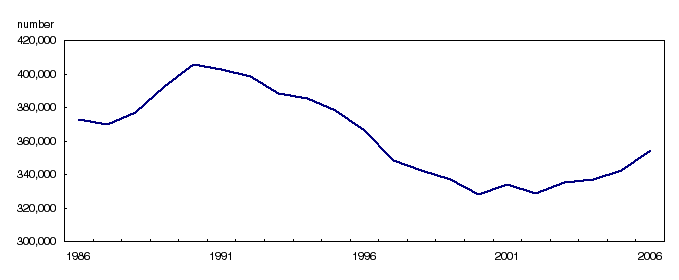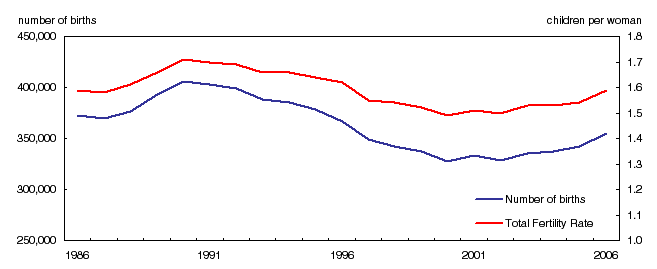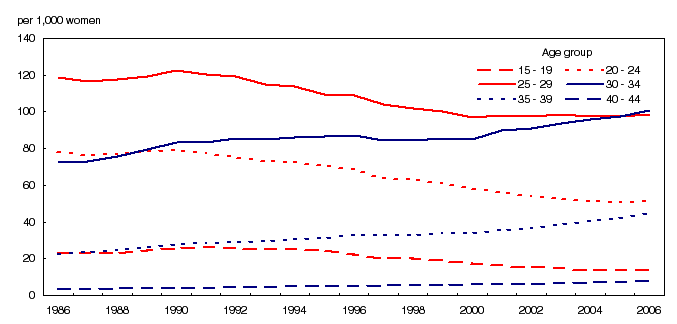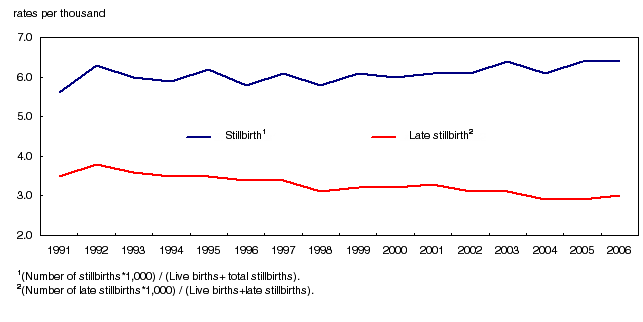Common menu bar links
2006
Archived Content
Information identified as archived is provided for reference, research or recordkeeping purposes. It is not subject to the Government of Canada Web Standards and has not been altered or updated since it was archived. Please "contact us" to request a format other than those available.
Analysis
A. Number of births
In 2006, 354,617 babies were born in Canada, the largest number of births since 1996 (366,200) and the highest annual increase (3.6%) since 1989 (4.2%).
A.1. Trends in births
Over the past 20 years, Canada has seen both upward and downward trends in the number of births (Chart 1). After peaking in 1990, the number of births fell steadily throughout the 1990s. In 2000, almost 328,000 births were registered, the lowest number since the end of World War II. In general, with the exception of 2002, there has been a recovery with an upward trend in the number of births since 2001.

A.2. Geographic differences
Between 2005 and 2006, the number of births rose in all provinces and territories except Nova Scotia and the Northwest Territories (Table 1). The largest differences from the national average occurred in the Yukon Territory (13.8%), Alberta (7.4%), Quebec (7.3%), Nunavut (6.9%) and Prince Edward Island (5.4%). However, Quebec and Alberta were the largest contributors accounting for 70% of the total increase.
| Place of residence of mother | 2005 | 2006 | Change | |
|---|---|---|---|---|
| number | percent | |||
| Canada | 342,176 | 354,617 | 12,441 | 3.6 |
| Newfoundland and Labrador | 4,501 | 4,542 | 41 | 0.9 |
| Prince Edward Island | 1,340 | 1,413 | 73 | 5.4 |
| Nova Scotia | 8,557 | 8,485 | -72 | -0.8 |
| New Brunswick | 6,892 | 7,030 | 138 | 2.0 |
| Quebec | 76,346 | 81,937 | 5,591 | 7.3 |
| Ontario | 133,760 | 135,595 | 1,835 | 1.4 |
| Manitoba | 14,145 | 14,565 | 420 | 3.0 |
| Saskatchewan | 11,967 | 12,288 | 321 | 2.7 |
| Alberta | 42,110 | 45,229 | 3,119 | 7.4 |
| British Columbia | 40,827 | 41,729 | 902 | 2.2 |
| Yukon Territory | 320 | 364 | 44 | 13.8 |
| Northwest Territories | 712 | 687 | -25 | -3.5 |
| Nunavut | 699 | 747 | 48 | 6.9 |
B. Fertility
The total fertility rate (TFR) estimates the average number of children a woman can be expected to have in her lifetime, based on the age-specific fertility rates of a given year. This is a cross-sectional measure that is not affected by variations in the size of the population or the age structure, thereby facilitating year-to-year comparisons.
B.1. General trends in fertility
The TFR in 2006 was 1.59 children per woman in Canada, up from the previous year (1.54) (Chart 2). This is the highest TFR recorded since 1996 (1.62) but is still well below the replacement level (2.1). This level represents the fertility rate that must be maintained to replace the population in the absence of migration. The last year that the total fertility rate exceeded the replacement level of generations was 1971. 1
In 2006, Nunavut, where the population is the youngest in Canada, had the highest fertility rate in the country, with a TFR of 2.84 children per woman, ensuring the generational replacement level. In contrast, Newfoundland and Labrador, which is among the oldest population in Canada, had the lowest TFR with 1.38 children per woman.
Other provinces with a TFR lower than the national average were Nova Scotia (1.40), British Columbia (1.41), New Brunswick (1.46), and Ontario (1.52). Saskatchewan was the province with the highest fertility, with 1.92 children per woman.
Closely paralleling the trend in births, the TFR fell throughout the 1990s and then began climbing in 2001. The drop in the TFR (and consequently, in the number of births) in 2000, and the quick recovery in 2001, may have been related to a desire to have a baby in the first year of the new millennium, given the increase in the number of marriages in 2000. 2
Between 2005 and 2006, the TFR rose in all provinces and territories except the Northwest Territories.

B.2. Age of mother and age-specific fertility rate
The average age of women giving birth rose steadily in the past 20 years, from 27.0 years in 1986 to 29.3 years in 2006.
From 2005 to 2006, all age-specific fertility rates increased, except in the 45 to 49 age group. Changes in fertility rates by province and territory differ from region to region. However, fertility rates for women in their thirties rose in all provinces between 2005 and 2006.

Over the past 20 years, there have been significant changes in the age-specific fertility rates in Canada (Chart 3). The trend among women to delay having children is evident when analysing fertility rates by age. 3 The fertility rate of women aged 30 to 34 surpassed that of women aged 20 to 24 in 1989 and then that of women aged 25 to 29 in 2006. An examination of fertility rates by geography for 2006 reveals that the fertility rate of women aged 30 to 34 surpassed that of women aged 25 to 29 only in Ontario, British Columbia, the Yukon Territory and Nova Scotia. In all other provinces and territories, and even if there was an increase in the fertility rate of women in their 30s, the age group with the highest fertility rate remained women aged 25 to 29.
The period between 1986 and 2006 saw a decline in the fertility rate of Canadian women in their twenties, while that of women in their thirties increased steadily. The gap continues to narrow between the fertility rates of women aged 20 to 24 and that of women aged 35 to 39.
B.3. Analyzing 2006 fertility rate
Two factors could account for the increases in the number of births in recent years: an increase in the number of women of reproductive age and/or a rise in fertility rates.
By applying age-specific fertility rates (ASFR) for 2005 to the female population in 2006 (Table 2), it is possible to estimate how much of the increase in births in 2006 can be attributed to changes in the size of the population compared to changes in fertility rates.
| Age Group | 2005 ASFR 1 | 2006 female population | Expected births 2 | 2006 ASFR 1 | Difference 3 |
|---|---|---|---|---|---|
| 15 to 19 | 13.4 | 1,058,976 | 14,190 | 13.7 | 0.3 |
| 20 to 24 | 50.4 | 1,104,984 | 55,721 | 51.1 | 0.7 |
| 25 to 29 | 97.3 | 1,106,368 | 107,613 | 98.5 | 1.2 |
| 30 to 34 | 97.4 | 1,103,287 | 107,497 | 100.9 | 3.5 |
| 35 to 39 | 42.1 | 1,171,444 | 49,306 | 44.9 | 2.8 |
| 40 to 44 | 7.1 | 1,344,766 | 9,575 | 7.4 | 0.3 |
| 45 to 59 | 0.3 | 1,339,495 | 426 | 0.3 | 0.0 |
| Total | 344,328 |
If there had been no change in age-specific fertility rates between 2005 and 2006, the number of births in 2006 would have been 344,328 (Table 2), or 2,152 births more than in 2005. However, the total increase between 2005 and 2006 was much higher, at 12,441 births. The additional 10,289 births can, therefore, be attributed to changes in fertility.
C. Echoes of the baby boom
The period between the end of World War II and the mid-1960s witnessed a dramatic increase in the fertility rates of women of childbearing age, the result of which was the baby boom.
C.1. Historical trends
In 1947, the TFR was 3.6 children per woman, the highest rate since 1921. 4 In that same year, the number of births totalled 372,600, and the crude birth rate was 28.9 per 1,000 population Chart 4).

At the height of the baby boom in 1959, annual births exceeded 479,000, the highest number recorded since comparable Canada-wide vital statistics were first compiled in 1921.
The annual number of births remained high for a few more years, and then dropped sharply starting in 1964. This period of relatively low births, known as the baby bust, lasted for approximately ten years until the mid-1970s.
C.2. Echo
The first baby boom “echo” was expected in the mid-1970s, approximately 25 years after the beginning of the baby boom. But while there was a sizeable increase in the number of births in 1974 and 1975, gains in the following years were relatively modest. Only in the late 1980s (1988 to 1990) was there a substantial rise in the number of births (Chart 4).
Between 1988 and 1995, Canada experienced a clear baby boom echo as the baby boomers had a large number of births, peaking at 405,486 in 1990. Thereafter, annual births dropped, falling to 327,882 in 2000, which was less than the lowest number in the baby bust period.
Over the past six years, Canada has seen an upward trend in the number of births, with the mean age of mothers at 29.3 years. The recent increase in births could be explained partly by the fact that currently, many women from the echo generation have entered their childbearing years and their fertility rates have edged up.
C.3. Comparison with other low-birth-rate countries
Low birth rate is a phenomenon that Canada shares with many countries. The rising number of births in Canada parallels trends in several other low-birth-rate countries, which have also experienced an upturn in fertility in recent years (Table 3).
From 2004 to 2006, the Czech Republic, Greece, Sweden, France and Norway have all registered a more significant jump in the total fertility rate than Canada.
| Country | 2004 | 2005 | 2006 |
|---|---|---|---|
| Czech Republic | 1.23 | 1.28 | 1.33 |
| Spain | 1.33 | 1.35 | 1.38 |
| Greece | 1.30 | 1.33 | 1.39 |
| Canada | 1.53 | 1.54 | 1.59 |
| Australia | 1.77 | 1.81 | 1.81 |
| Denmark | 1.78 | 1.80 | 1.83 |
| United Kingdom | 1.78 | 1.80 | 1.84 |
| Sweden | 1.76 | 1.77 | 1.85 |
| Norway | 1.83 | 1.84 | 1.90 |
| France | 1.92 | 1.94 | 2.00 |
D. Change in stillbirths
The number of stillbirths (or fetal deaths) in Canada was 2,272 in 2006, an increase of 63 stillbirths (2.9%) from 2005.
The stillbirth rate remained stable at 6.4 per 1,000 total births (live births and stillbirths) between 2005 and 2006.
D.1. Trends in stillbirth rates
Since 1991, stillbirth rates have fluctuated around 6.0 per 1,000 total births (Chart 5). The lowest rate was 5.6 in 1991 and the highest was 6.4 in 2003, 2005 and 2006. However, the late stillbirth rate (fetal deaths at 28 or more weeks of gestation) peaked at 3.8 per 1,000 in 1992, and has since decreased to 3.0 in 2006.

D.2. Stillbirth rates, by geography
Stillbirth rates varied considerably across Canada in 2006, from 4.0 per 1,000 total births in Quebec to 12.9 per 1,000 in the Northwest Territories (Table 4). Four provinces and one territory registered stillbirth rates below the national average: Quebec, Prince Edward Island, New Brunswick, Saskatchewan and the Yukon Territory. In all the other provinces and territories, stillbirth rates were above the national average.
| Place of residence of mother | Stillbirths (fetal deaths) | |
|---|---|---|
| number | rate 1 | |
| Quebec | 329 | 4.0 |
| Prince Edward Island | 6 | 4.2 |
| New Brunswick | 34 | 4.8 |
| Yukon Territory | 2 | 5.5 |
| Saskatchewan | 77 | 6.2 |
| Canada | 2,272 | 6.4 |
| Alberta | 302 | 6.6 |
| Ontario | 950 | 7.0 |
| Newfoundland and Labrador | 32 | 7.0 |
| Manitoba | 112 | 7.6 |
| British Columbia | 334 | 7.9 |
| Nova Scotia | 76 | 8.9 |
| Nunavut | 9 | 11.9 |
| Northwest Territories | 9 | 12.9 |


